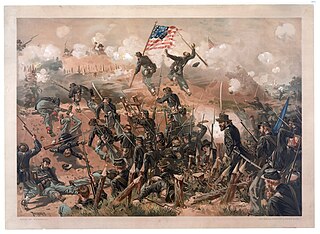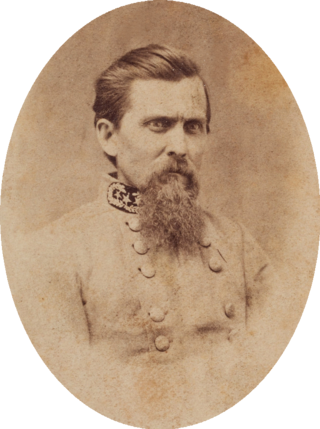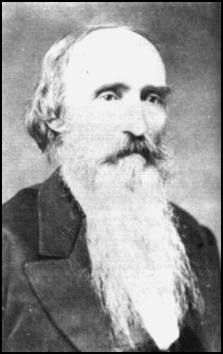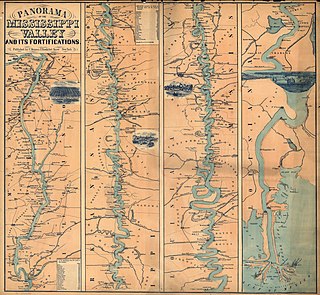
The siege of Vicksburg was the final major military action in the Vicksburg campaign of the American Civil War. In a series of maneuvers, Union Major General Ulysses S. Grant and his Army of the Tennessee crossed the Mississippi River and drove the Confederate Army of Mississippi, led by Lieutenant General John C. Pemberton, into the defensive lines surrounding the fortress city of Vicksburg, Mississippi, leading to the successful siege and Confederate surrender.

The Vicksburg campaign was a series of maneuvers and battles in the Western Theater of the American Civil War directed against Vicksburg, Mississippi, a fortress city that dominated the last Confederate-controlled section of the Mississippi River. The Union Army of the Tennessee under Major General Ulysses S. Grant gained control of the river by capturing this stronghold and defeating Lieutenant General John C. Pemberton's forces stationed there.

The Army of the Tennessee was a Union army in the Western Theater of the American Civil War, named for the Tennessee River. A 2005 study of the army states that it "was present at most of the great battles that became turning points of the war—Fort Donelson, Vicksburg, and Atlanta" and "won the decisive battles in the decisive theater of the war."
Army of the Mississippi was the name given to two Union armies that operated around the Mississippi River, both with short existences, during the American Civil War.

John Alexander McClernand was an American lawyer, politician, and a Union Army general in the American Civil War. He was a prominent Democratic politician in Illinois and a member of the United States House of Representatives before the war. McClernand was firmly dedicated to the principles of Jacksonian democracy and supported the Compromise of 1850.

Frederick Steele was a career military officer in the United States Army, serving in the Mexican-American War, the Yuma War, and as a major general in the Union Army during the American Civil War. He was most noted for retaking much of secessionist Arkansas for the Union cause, escaping the besieged port-city of Camden through successful deception tactics, and defeating Sterling Price and E. Kirby Smith at Jenkins Ferry.

The Mississippi River Squadron was the Union brown-water naval squadron that operated on the western rivers during the American Civil War. It was initially created as a part of the Union Army, although it was commanded by naval officers, and was then known as the Western Gunboat Flotilla and sometimes as the Mississippi Flotilla. It received its final designation when it was transferred to the Union Navy at the beginning of October 1862.

The Battle of Chickasaw Bayou, also called the Battle of Walnut Hills, fought December 26–29, 1862, was the opening engagement of the Vicksburg Campaign during the American Civil War. Confederate forces under Lt. Gen. John C. Pemberton repulsed an advance by Union Maj. Gen. William T. Sherman that was intended to lead to the capture of Vicksburg, Mississippi.

Laurent Millaudon was a wooden side-wheel river steamboat launched at Cincinnati, Ohio, in 1856 operating in the New Orleans, Louisiana, area, and captained by W. S. Whann. At the beginning of the American Civil War she was taken into service by the Confederate Navy as CSS General Sterling Price. On 6 June 1862, she was sunk at the First Battle of Memphis. She was raised and repaired by the Union army, and on 16 June 1862 was moved into Union service as USS General Price and served until the end of the war.

The western theater of the American Civil War encompassed major military operations in the states of Alabama, Georgia, Florida, Mississippi, North Carolina, Kentucky, South Carolina and Tennessee, as well as Louisiana east of the Mississippi River. Operations on the coasts of these states, except for Mobile Bay, are considered part of the Lower Seaboard Theater. Most other operations east of the Appalachian Mountains are part of the eastern theater. Operations west of the Mississippi River took place in the trans-Mississippi theater.
The trans-Mississippi theater of the American Civil War was the scene of the major military operations west of the Mississippi River. The area is often thought of as excluding the states and territories bordering the Pacific Ocean, which formed the Pacific coast theater of the American Civil War (1861–1865).

Carter Littlepage Stevenson Jr. was a career military officer, serving in the United States Army in several antebellum wars and then in the Confederate States Army as a general in the Western Theater of the American Civil War.
The Mississippi River campaigns, within the Trans-Mississippi Theater of the American Civil War, were a series of military actions by the Union Army during which Union troops, helped by Union Navy gunboats and river ironclads, took control of the Cumberland River, the Tennessee River, and the Mississippi River, a main north-south avenue of transport.

Franklin Kitchell Gardner was a Confederate major general in the American Civil War, noted for his service at the Siege of Port Hudson on the Mississippi River. Gardner built extensive fortifications at this important garrison, 16,000 strong at its peak. At the mercy of conflicting orders, he found himself besieged and greatly outnumbered. His achievement at holding out for 47 days and inflicting severe losses on the enemy before surrendering has been praised by military historians.

Major-General John George Walker was a Confederate general in the American Civil War. He served as a brigadier general under Stonewall Jackson and James Longstreet, before commanding the Texas Division unit in the Trans-Mississippi Department, known as Walker's Greyhounds for their speed and agility. He was ordered to disrupt U.S. Grant's supply-line opposite Vicksburg, Mississippi, but Grant had managed to cross to the East Bank, and Walker was reduced to minor operations, one of them against some of the first African-American troops to serve in battle. He was able to make a bigger contribution to the Red River Campaign in support of General Richard Taylor.

The Army of Central Kentucky was a military organization within Department No. 2. Originally called the Army Corps of Central Kentucky, it was created in the fall of 1861 as a subsection of Department No. 2, and continued in existence until the end of March 1862 when it was absorbed and merged into the Army of Mississippi, which was then re-organized as the Army of Tennessee on November 20, 1862.

Claudius Wistar Sears was a United States Army officer, an educator, and a Confederate general during the American Civil War.

The Army of West Tennessee was a short-lived Confederate army led by Maj. Gen. Earl Van Dorn, which fought principally in the Second Battle of Corinth.

On the onset of the American Civil War in April 1861, Ulysses S. Grant was working as a clerk in his father's leather goods store in Galena, Illinois. When the war began, his military experience was needed, and congressman Elihu B. Washburne became his patron in political affairs and promotions in Illinois and nationwide.

The Mississippi River was an important military highway that bordered ten states, roughly equally divided between Union and Confederate loyalties.
















